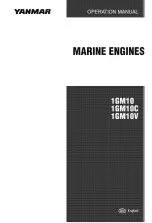
50 - 97
Instruction Manual
AC 02/2019-rev.1.1
5.11 ALIMENTAZIONE
L’elevata frequenza di commutazione degli
inverter di ultima generazione sottopone il motore
a stress elettrodinamici notevoli, in particolar
modo per quanto riguarda il sistema di
isolamento ed i cuscinetti.
I fronti molto ripidi della tensione di uscita
dell’inverter generano elevate correnti e tensioni
capacitive all’interno del motore con conseguente
possibilità di danneggiamento degli avvolgimenti
(scariche tra le fasi o verso massa) e/o dei
cuscinetti a causa delle correnti parassite o
correnti d’albero (fenomeno conosciuto come
EDM).
Questi fenomeni si manifestano in casi sporadici
e sono difficilmente prevedibili in quanto le
condizioni di installazione dei motori, la
realizzazione dell’impianto elettrico ed i luoghi di
utilizzo sono molto variabili. In generale la
presenza di cavi di alimentazione molto lunghi tra
motore ed inverter, l’utilizzo a velocità e carico
costanti e le frequenze di commutazione elevate
sono condizioni che favoriscono questi fenomeni
indesiderati.
E’ pertanto necessario provvedere ad una
corretta installazione dell’inverter e del cablaggio
del motore considerando i seguenti aspetti:
-
Utilizzo di cavi appropriati con sezione
simmetrica e schermo concentrico.
-
Utilizzo di conduttori di terra a bassa
impedenza e realizzazione dell’impianto
idoneo per dispersioni ad alta frequenza
-
Utilizzo del cuscinetto posteriore isolato
elettricamente.
-
Utilizzo di induttanze e/o filtri du/dt tra motore
ed inverter.
5.11 POWER SUPPLY
The high switching frequency of the latest
generation of inverters subjects the motor to
notable electrodynamic stress, in particular
affecting the stator insulation system and the
bearings.
The steep output voltage curves of the inverter
generate high capacitive currents and voltages in
the motor which can deteriorate and damage the
insulation system of the windings (discharges
between the phases or to earth) and/or the
bearings and transducer due to eddy currents or
ground currents in the shaft (a phenomenon
known as EDM).
These phenomena occur in sporadic cases that
are hard to predict due to a variety of different
motor installation conditions, plant installations
and places of use. In general, the long power
shielded cables used between the motor and the
inverter, the utilization of the motor at fixed speed
and load and the high switching frequencies are
conditions that increases the possibilities to get
these unwanted phenomena.
Therefore, the inverter must be installed correctly
and the motor wired up in consideration of the
following factors:
-
Use appropriate cables with a symmetrical
section and concentric screen.
-
Use earth conductors with a low impedance
and install a suitable high-frequency dispersion
system.
-
Use an electrically insulated non drive-end
side bearing.
-
Use inductances and/or du/dt filters between
the motor and the inverter.
5.11 STROMVERSORGUNG
Durch die hohe Umschaltfrequenz der Inverter der
letzten Generation wird der Motor beträchtlichen
elektrodynamischen Beanspruchungen,
insbesondere hinsichtlich Isolierung und Lager,
ausgesetzt.
Die äußerst steilen Spannungsflanken aus dem
Inverter erzeugen hohe kapazitive Ströme und
Spannungen im Motorinneren, die aufgrund der
Wirbel- oder Wellenströme (als EDM bekanntes
Phänomen) Schäden an den Wicklungen
(Überschlag zwischen den Phasen oder zur Erde)
und/oder Lagern verursachen können.
Diese Phänomene treten sporadisch auf und sind
schwer vorhersehbar, da die Installation-
sbedingungen der Motoren, die Ausführung der
Elektroanlage und die Betriebsorte sehr
unterschiedlich sein können. In der Regel sind sehr
lange Zuleitungskabel zwischen Motor und Inverter,
Betrieb bei konstantem Drehmoment und
konstanter Last und hohe Umschalt-frequenzen
Faktoren, die diese unerwünschten Phänomene
begünstigen.
Inverterinstallation und Verkabelung des Motors
müssen deswegen unter Berücksichtigung
folgender Aspekte korrekt erfolgen:
-
Verwendung geeigneter Kabel mit
symmetrischem Querschnitt und konzentrischer
Abschirmung.
-
Verwendung von niederohmigen Erdleitungen
und Einrichtung einer für hochfrequente Verluste
geeigneten Anlage.
-
Verwendung eines elektrisch isolierten Lagers
hinten.
-
Verwendung von Induktanzen und/oder du/dt-
Filtern zwischen Motor und Inverter.
PWM MODULATION
VOLTAGE RISE TIME -
SPANNUNGSANSTIEG
CAVO SCHERMATO
–
ABGESCHIRMTES
KABEL
CAVO SIMMETRICO
–
SYMETRISCHES
KABEL
MOTORE SENZA CUSCINETTO ISOLATO
MOTOR WITHOUT INSULATED BEARING
MOTOR OHNE ISOLIERTES LAGER
MOTORE CON CUSCINETTO ISOLATO
MOTOR WITH INSULATED BEARING
MOTOR MIT ISOLIERTEM LAGER
















































